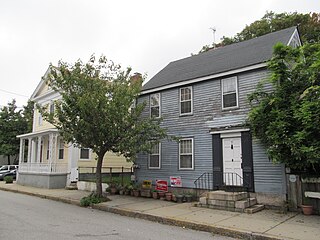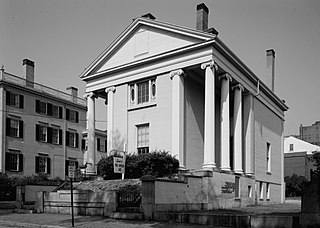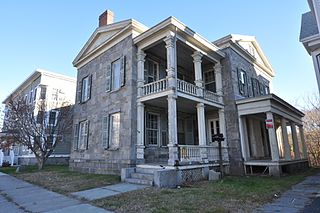
The House of the Seven Gables is a 1668 colonial mansion in Salem, Massachusetts, named for its gables. It was made famous by Nathaniel Hawthorne's 1851 novel The House of the Seven Gables. The house is now a non-profit museum, with an admission fee charged for tours, as well as an active settlement house with programs for children. It was built for Captain John Turner by Samuel Wardwell and stayed with the family for three generations.

Ye Antientist Burial Ground is a cemetery in New London, Connecticut, bounded by Hempstead Street on the west and Huntington Street on the east, running from Granite Street to approximately Bristol Street. It has been known by several names over the years, many spelling variations on Ancient Burial Ground. It is one of the earliest graveyards in New England and the oldest colonial cemetery in New London County. The hillside lot of 1.5 acres and adjoins the site of New London's first meeting house. The settlement at the time was called "Pequot Plantation" until the name changed in 1658. From the burial grounds, the visitor has a broad view to the east of the Thames River and, on the far shore, the heights of Groton, Connecticut.

The Andrew John Volstead House is the historic house in Granite Falls, Minnesota, of ten-term United States Congressman Andrew Volstead (1860–1947). It is now managed as a museum and the organizational headquarters of the Granite Falls Historical Society. Volstead became nationally synonymous with Prohibition in 1919 when, as chairman of the House Judiciary Committee, he was obliged to author the Volstead Act, enabling enforcement of the recently ratified Eighteenth Amendment. Volstead was a moderate progressive who coauthored the Capper–Volstead Act in 1922, which legalized agricultural cooperatives.

The Simon Cameron House, also known as John Harris Mansion and the Harris–Cameron Mansion, is a historic house museum at 219 South Front Street in Harrisburg, Pennsylvania. Built in 1766 and frequently extended and altered, it is one of Harrisburg's oldest buildings, and is nationally notable as the summer residence of Simon Cameron (1799–1889), an influential Republican Party politician during and after the American Civil War. The house and family items were donated to the Historical Society of Dauphin County in 1941, which now operates it as a museum. The mansion was declared a National Historic Landmark in 1975, and is located in the Harrisburg Historic District.

The Pope House Museum, built in 1901, is a restored home once owned by Dr. Manassa Thomas Pope, a prominent African-American citizen of Raleigh, North Carolina. The Pope House is listed on the National Register of Historic Places in 1999, It was an official project of the Save America’s Treasures Program and the city of Raleigh took over management of it, offering tours for the first time in 2012.

The Harrison House, also known as Harrison–Linsley House and incorrectly as the Swain-Harrison House, is a historic house museum at 124 Main Street in Branford, Connecticut. Built in 1724 by a descendant of Branford's founders, it is a good example of a Connecticut saltbox structure. The house was listed on the National Register of Historic Places in 1975, and is a contributing property to the Canoe Brook Historic District. Since 2016 it has been operated as a house museum by the Branford Historical Society.

The Nathaniel Backus House is a two-story Greek Revival clapboarded house with a gable roof in Norwich, Connecticut. The house was built around 1750 by Nathaniel Backus and served as his home, it was later moved to its current location in 1952. The house originally began as a Colonial, but was greatly modified to Greek Revival around 1825, reconfiguring the central door to the left of the facade and adding two chimneys. The house is a historic house museum operated by the Faith Trumbull Chapter of the Daughters of the American Revolution.

The Coit Street Historic District in New London, Connecticut is a historic district that was listed on the National Register of Historic Places in 1988. It includes 33 contributing buildings over a 4 acres (1.6 ha) area, located just southwest of the city's central business district. The area included in the district was formerly known as Bream Cove, which was filled in and developed in the 19th century. The area includes four out of twelve surviving 18th-century buildings in the city. It includes all of the properties on Coit and Brewer Streets, as well as those on Blinman Street between those two streets.

The New London Custom House is a historic custom house at 150 Bank Street in New London, Connecticut, built in 1833-35. It was designed by Robert Mills, one of the country's first formally trained architects. From 1839-40, the schooner La Amistad, on which captured Africans meant for the slave trade rebelled, was impounded at a wharf behind the customhouse. It was listed on the National Register of Historic Places for its architecture in 1970, and is now a local museum covering the city's maritime history.

The Whitehall Mansion is a historic house at 42 Whitehall Avenue in the Stonington side of Mystic, Connecticut. Built about 1771 for a local physician and politician, it is a fine example of late Georgian architecture. It has been moved twice, both times short distances, and now serves as a bed and breakfast inn. The house was added to the National Register of Historic Places on April 12, 1979.

The Nathaniel Hempstead House, also known as the Old Huguenot House, is a historic house museum on Hempstead Street in New London, Connecticut. Built about 1759, it is an architecturally unusual stone house with a gambrel roof, a style not otherwise seen in the city. Because of its unusual form, it was thought to have been built by French Huguenot immigrants at an earlier date. The house is owned by Connecticut Landmarks, along with the adjacent Joshua Hempsted House, operating the pair as the Hempstead Houses museum. The house was listed on the National Register of Historic Places on December 2, 1970.

The Perkins-Rockwell House is a historic house museum at 42 Rockwell Street in Norwich, Connecticut. Built in 1818, it is locally distinctive as a well-preserved stone house of the Federal period, and for its association with the locally prominent Perkins and Rockwell families; this house was home to John A. Rockwell, a prominent local lawyer who married into the Perkins family, and also served as a member of Congress. The house was listed on the National Register of Historic Places on October 17, 1985. The house is currently owned by the Faith Trumbull Chapter of the Daughters of the American Revolution (DAR), along with the adjacent Nathaniel Backus House.

The Charles Q. Clapp House is a historic house at 97 Spring Street in central Portland, Maine. Built in 1832, it is one of Maine's important early examples of high style Greek Revival architecture. Probably designed by its first owner, Charles Q. Clapp, it served for much of the 20th century as the home of the Portland School of Fine and Applied Art, now the Maine College of Art. It is now owned by the adjacent Portland Museum of Art. It was listed on the National Register of Historic Places in 1972.

The Perkins Stone Mansion is a historic house museum in Akron, Ohio, United States.
Nathaniel Shaw Jr. (1703—1778) was a Connecticut Patriot, and an American Revolutionary War soldier. He is frequently referred to as "Captain Nathaniel Shaw, Jr."
The Benjamin C. Wilder House is an historic house at 1267 Main Street in Washburn, Maine. Built about 1852, it is a well-preserved example of mid-19th century vernacular architecture in northern Aroostook County, built in the first decade after widespread settlement began of the area. The house was listed on the National Register of Historic Places in 1987. It is now owned by the local Salmon Brook Historical Society and operated as a historic house museum.

The Thomas A. Hill House, also formerly known as the Grand Army Memorial Home, is a historic house at 159 Union Street in Bangor, Maine. Now housing the collections of the Bangor Historical Society and an American Civil War collection, the house was built in 1836 to a design by Richard Upjohn. The house has been home to two of Bangor's mayors, and became a museum in 1944. It was listed on the National Register of Historic Places in 1972.

The John I. Howe House is a historic house at 213 Caroline Street in Derby, Connecticut. Built in 1845, it is a distinctive example of Greek Revival architecture executed in granite, built for John Ireland Howe of the Howe Pin Company. It was listed on the National Register of Historic Places in 1989.

The Ebenezer Gay House, also known locally as the Gay-Hoyt House, is a historic house museum at 18 Main Street in Sharon, Connecticut. Built in 1775, it is a well-preserved example of Georgian colonial architecture in brick. It was listed on the National Register of Historic Places in 1979, and is part of the Sharon Historic District, listed in 1993. It is now home to the Sharon Historical Society.





















